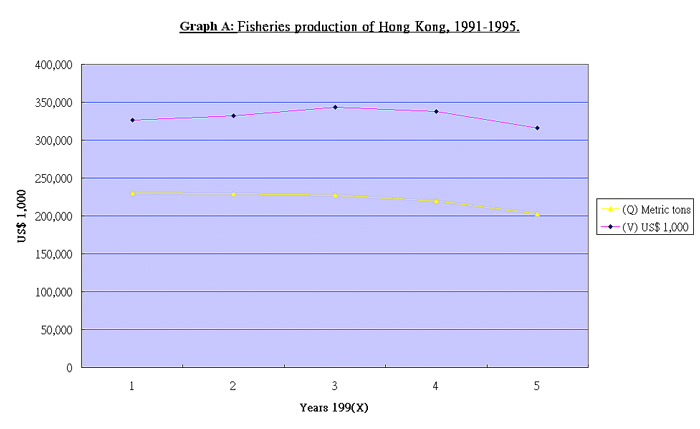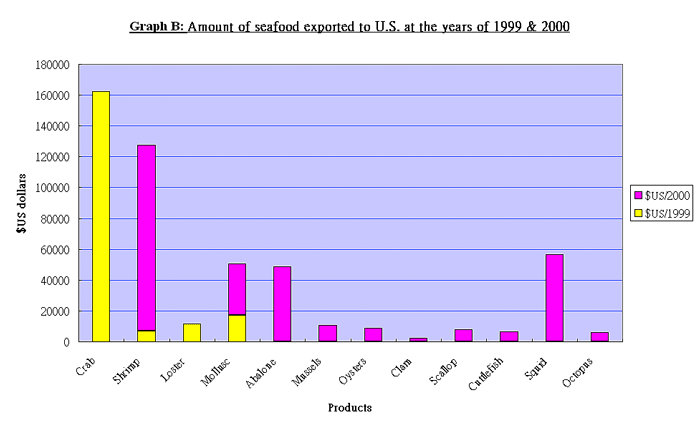Economic Importance
Fisheries Production
![]() Swimming
crabs caught
in Hong Kong are valued at 5,542 (US$ 1,000) in 1995. (See Table
B). Most crabs are caught either by conventional crab pots,
or by tangle nets. On the seashore a very large number of different species
of crabs are found, but most of them are small in size and therefore rarely
for human consumption. Perhaps the only shore crabs still caught in great
numbers are the mangrove crab Scylla serrata, which occurs in the
Mai Po marshes and throughout the muddy bottom of intertidal and subtidal
zones of Indo-Pacific regions. Scylla serrata of different life
stages can be found on local markets, including the male species with
strong muscle meat, the female species with nutritious eggs, the molting
species with a new soft shell grown beneath the old hard one, and the
juvenile species. Owing to their great demand in the markets, Scylla
is extensively cultured in many provinces of Southern China.
Swimming
crabs caught
in Hong Kong are valued at 5,542 (US$ 1,000) in 1995. (See Table
B). Most crabs are caught either by conventional crab pots,
or by tangle nets. On the seashore a very large number of different species
of crabs are found, but most of them are small in size and therefore rarely
for human consumption. Perhaps the only shore crabs still caught in great
numbers are the mangrove crab Scylla serrata, which occurs in the
Mai Po marshes and throughout the muddy bottom of intertidal and subtidal
zones of Indo-Pacific regions. Scylla serrata of different life
stages can be found on local markets, including the male species with
strong muscle meat, the female species with nutritious eggs, the molting
species with a new soft shell grown beneath the old hard one, and the
juvenile species. Owing to their great demand in the markets, Scylla
is extensively cultured in many provinces of Southern China.
![]() Shrimps
In Hong Kong, the major commercial
significant prawns including Penaeus japonicus, P. monodon,
P. semisulcatus, and Metapenaeus ensis, are caught by beam
trawling boats which tow a number of bottom dredges along the surface
of the mud. Some prawns are caught in the Deep Bay marshes where they
constitute some 50% of the total catch. According to the statistics of
SEAFDEC, penaeid prawns caught in Hong Kong in 1995 are valued at 30,854
(US$ 1,000), which is the highest valued species in 1995.
See Table B.
Shrimps
In Hong Kong, the major commercial
significant prawns including Penaeus japonicus, P. monodon,
P. semisulcatus, and Metapenaeus ensis, are caught by beam
trawling boats which tow a number of bottom dredges along the surface
of the mud. Some prawns are caught in the Deep Bay marshes where they
constitute some 50% of the total catch. According to the statistics of
SEAFDEC, penaeid prawns caught in Hong Kong in 1995 are valued at 30,854
(US$ 1,000), which is the highest valued species in 1995.
See Table B.
![]() Cephalopods
Cephalopods have significant contribution to
the total annual fish landings in Hong Kong. Of which, squids are of major
importance in Hong Kong. About 10,043 metric tons of squids are caught
worth 22,209 (US$ 1,000) in 1995. (See Table
B). Mainly Loligo edulis and L. forosana, which
are caught by pair and stern trawlers with its peak during summer. Similarly,
cuttlefish has the production of about 1,689 metric tons, worth 2,847
(US$ 1,000) in 1995. (See Table B). The landings are
mainly composed of Sepia pharaonis, S. recurvirostra,
S. lycidas and S. aculeata, setc., which are caught by pair
and stern trawlers on the continental shelf, while octopus are of minor
importance among cephalopods. The major species in Hong Kong is Octopus
membranaceus.
Cephalopods
Cephalopods have significant contribution to
the total annual fish landings in Hong Kong. Of which, squids are of major
importance in Hong Kong. About 10,043 metric tons of squids are caught
worth 22,209 (US$ 1,000) in 1995. (See Table
B). Mainly Loligo edulis and L. forosana, which
are caught by pair and stern trawlers with its peak during summer. Similarly,
cuttlefish has the production of about 1,689 metric tons, worth 2,847
(US$ 1,000) in 1995. (See Table B). The landings are
mainly composed of Sepia pharaonis, S. recurvirostra,
S. lycidas and S. aculeata, setc., which are caught by pair
and stern trawlers on the continental shelf, while octopus are of minor
importance among cephalopods. The major species in Hong Kong is Octopus
membranaceus.
Aquaculture in Hong Kong
Gei Wai Shrimps
To cope with the unlimited demand in the market, aquaculture of certain species are practiced in Hong Kong, which claim about 12% annually of the total fisheries production. Several species are cultivated in shrimp ponds or gei wais in Deep Bay marshes including Metapenaeus ensis, M. affinis, Penaeus penicillatus, P. merguiensis and P. monodon. Of these, the most important harvest is M. ensis, so they are called 'gei wai ha'.
The principle of gei wai operation is to create
a strong current through the sluice gates. During high tides, the sluice
gates are opened so as to drain as many juvenile shrimps as possible into
the gei wais. As time passes by, the juvenile shrimps grow into a marketable
size, which can be ready for harvest. During low tides, the sluice gates
are opened so that the large adult shrimps are flooded out of the gei
wais and trapped into the nets. This allows for a maximum of about 100
harvests each year. In a good harvest as many as 20 catties (12kg) of
shrimps may be collected, with a possible market value exceeding HK$2000.
Oyster cultivation
Similarly, oysters have been cultured along the intertidal mud flat of Deep Bay in north western corner of Hong Kong for some considerable time. Oysters were used to be cultured by the bottom laying method with spat collected by laying old shells, rocks or concrete pile or post as clutches on the mud flat in May or June. In recent years, with repeated failure in spat collection, farmers turned to fattening of young oysters imported from the Mainland. The process would take about six to twelve months before the oysters ready for marketing. For operational convenience and faster growth, fattening is carried out mostly by raft culture. Pacific oyster or Japanese oyster, Crassostrea gigas, is the main aquaculture species comprising the total oyster production of about 64 tonnes, valued at $4 million in 1998. Most of the oysters are marketed at Lau Fau Shan where they are either removed from the shell for local consumption or are retailed intact for sale in the other local markets or restaurants.
Trade as processed Food
Apart from serving as fresh food, most of the fresh seafood can be made into dried or canned food. For example, Solenocera crassicornis are commonly processed as dried food. Paste made of crab meat or fat and dried eggs is an excellent seasoning. Most of the molluscs are always marketed as delicious luxurious dried food or canned food which include Chlamys sp., Pinna pectinata, Heliotis diversicolor and Hemifusus ternatanus, and the cuttlefish, squid and octopus.
Exports
Besides contributing to the domestic markets, some species are sold to other countries in a profitable price, such as Scylla as fresh food, Portunus trituberculatus and Panulirus sp. as frozen food, the abdomens of spiny lobsters are exported as 'frozen tail' etc. The fishery commodities including crabs, shrimps, squid, cuttlefish, octopus, mussels, molluscs, sea cucumber etc. in the preparation of fresh, frozen, dried, salted, brine, sauces and other edible products. In 1995, a total of 182,242 metric tons of fishery commodities worth 619,432 (US$ 1,000) are exported. Of which, fresh or frozen shrimps, prawns and lobsters have composed the highest valued of 101,594 (US$1,000) (See Table C). The destination includes Canada, China, Germany, Japan, Netherlands, Spain, Taiwan, U.S.A., Macau, Belgium & Lukxemberg etc. (See Table D). For example, the amount of seafood exported to U.S.A. is worth US$ 893,642 and 872,837 in January 1999 & 2000 respectively. See Graph B below and Table E & Table F.
Fresh, and nutritious seafood is always the spirit for various delicious dishes. Either serving as live, fresh, boiled, steamed, chilled, fried, or baked, seafood is always the popular dishes in many restaurants. Of all the species, Charydbis feriata (swimming crab), Metapenaeus ensis (gei wai ha), Penaeus japonicus (Japanese prawn), Panulirus versicolor (striped spiny lobster), Heliotis diversicolor (Japanese abalone), Crassostrea gigas (Pacific oyster) and Holothuria arenicola (sea cucumber) etc. are the major high priced seafood in Hong Kong. Table G shows the current retail price of the common seafood in local markets.
Functions other than food The function of the marine creatures is not restricted to as seafood only, but many underlying uses are still remained to be discovered. In old ages, Hemifusus sp. have been used as a horn for recreational use. Some of the colorful species like Chlamys sp. and Melo sp. are collected as ornaments and containers. While Heliotis sp. are used for jewelry, buttons and inlays. The shell of many molluscs can be sold for the manufacture of lime. Moreover, many crabs can serve as feed for fish cultures, for turtles and domestic birds and other animals. On duck farms, food mixed with crab powder not only stimulates growth and the fattening of ducks, but may also raise their spawning rate. Furthermore, dried seafood are on sale and widely used by Asian people as soup ingredients. Because they believe that seafood have potent medical contribution to good health.
In conclusion, it is undeniable that marine invertebrates are important, both in its delicacy as seafood and its tremendous economic value to Hong Kong.

